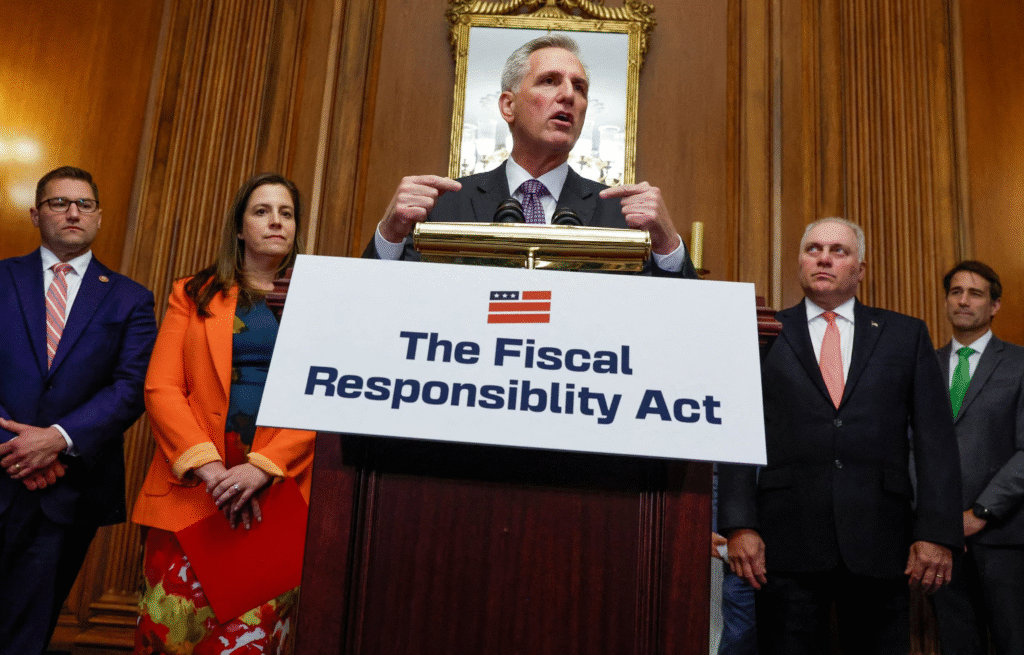![Debt Ceiling 2025: Fiscal Responsibility or Political Strategy? [The Shocking Truth Behind America’s $36 Trillion Debate] Debt Ceiling 2025: Fiscal Responsibility or Political Strategy? [The Shocking Truth Behind America’s $36 Trillion Debate]](https://action-print.com/wp-content/uploads/2025/10/debt-ceiling-2025-fiscal-responsibility-or-political-strategy-the-shocking-truth-behind-americas-36-trillion-debate.png)
Is the U.S. debt ceiling debate truly about fiscal responsibility—or just political strategy? Explore America’s $36 trillion dilemma, real-world consequences, historical context, reforms, and 10 FAQs that define the debt ceiling crisis of 2025.
debt ceiling 2025, U.S. debt crisis, political strategy, fiscal responsibility, debt ceiling debate, government default risk, X Date, U.S. default
The U.S. debt ceiling debate swings between genuine fiscal restraint and partisan political strategy. While politicians claim moral high ground on fiscal discipline, their timing and tactics often reveal strategic leverage. This deep dive explores the roots, consequences, and reform options behind America’s $36 trillion debt dilemma—and why it matters more than ever in 2025.
Why the Debt Ceiling Debate Matters Now
The U.S. debt ceiling isn’t a cap on new government spending—it’s a legal limit on how much the Treasury can borrow to pay bills already approved by Congress. Yet, over time, it has morphed from a bureaucratic formality into one of the most dramatic political showdowns in Washington.
As of early 2025, America’s national debt exceeds $36.2 trillion, with the statutory debt ceiling reinstated at roughly $36.1 trillion. The Treasury is again relying on “extraordinary measures” to stay solvent while lawmakers clash over ideological priorities.
When the ceiling isn’t raised in time, the U.S. risks defaulting on its obligations—a move that would send shockwaves through global financial markets, raise interest rates, and undermine trust in the dollar’s dominance.
But here’s the million-dollar question: Is this debate really about fiscal discipline—or just political theater?
Let’s break it down.
What Is the Debt Ceiling and How Does It Work?
The Definition and Purpose
The debt ceiling is a statutory limit on how much the U.S. Treasury can borrow to meet existing legal obligations—such as Social Security payments, defense spending, and interest on the national debt.
Raising the debt ceiling does not authorize new spending. It simply allows the government to fulfill obligations it has already made.
In other words, refusing to raise it is like refusing to pay your credit card bill after you’ve already spent the money.

What Happens When We Hit the Debt Ceiling?
Once the ceiling is reached, the Treasury uses accounting tactics known as “extraordinary measures” to free up cash temporarily. These include:
- Suspending investments in certain federal funds
- Redeeming special securities early
- Shuffling internal accounts to delay payments
Eventually, though, these measures run out. That’s when we reach the “X Date”—the day the government no longer has enough money to meet all of its obligations.
If the ceiling isn’t lifted before the X Date, the U.S. could default for the first time in history—a catastrophic event that would:
- Shake global markets
- Cause credit rating downgrades (as in 2011)
- Spike borrowing costs
- Delay Social Security and veterans’ benefits
- Trigger recession fears
How Often Has the Debt Ceiling Been Raised?
Since 1960, Congress has raised or suspended the debt ceiling 78 times—a bipartisan pattern. Both Republican and Democratic administrations have done so regularly to avoid default.
However, in recent years, each increase has come with intensifying political brinkmanship, turning a once-routine process into a headline-grabbing crisis.
Is the Debt Ceiling Debate About Fiscal Responsibility—or Political Strategy?
Theoretically, the debate should be about controlling reckless spending. But in reality, the debt ceiling has become a political weapon—used by both parties to push unrelated agendas and extract concessions.
Arguments for Fiscal Responsibility
Supporters of strict debt ceilings argue that:
- It forces Congress to face fiscal realities and address deficits.
- It encourages reforms and long-term spending restraint.
- It signals to global investors that the U.S. takes debt seriously.
- It helps curb inflationary pressures by reducing borrowing appetite.
This stance appeals to those who view government debt as a moral issue, burdening future generations.
Arguments for Political Strategy
Critics say the debt ceiling fight is less about fiscal prudence and more about political theater.
They argue that:
- Both parties regularly approve spending and then grandstand over repayment.
- These standoffs are often timed to coincide with elections or to damage political opponents.
- They create unnecessary market turmoil.
- The supposed “discipline” rarely results in genuine structural reform.
Economists call the modern debt ceiling “a hostage-taking mechanism”—a tool to force negotiations under the threat of economic collapse.
Real-Life Examples That Reveal the Truth
The 2011 Debt Ceiling Crisis
In 2011, House Republicans demanded deep budget cuts before agreeing to raise the ceiling for President Obama. The standoff dragged on for months, leading to:
- A historic U.S. credit downgrade by Standard & Poor’s
- Stock market volatility
- A late compromise called the Budget Control Act of 2011, introducing spending caps
While the ceiling was eventually raised, the damage to U.S. credibility was already done.

The 2023–2025 Fiscal Responsibility Act Battle
In 2023, President Biden and House Republicans reached a deal—the Fiscal Responsibility Act—which suspended the debt ceiling until January 2025.
As of early 2025, the limit has been reinstated, and the Treasury has begun using extraordinary measures again.
Lawmakers, including Senator Rand Paul, have opposed large increases without reforms, while others propose abolishing the debt ceiling entirely, calling it “a dangerous relic.”
Credit rating agencies like Fitch have warned that continued political brinkmanship could trigger further downgrades.
10 Trending Questions Americans Are Asking About the Debt Ceiling
1. What Is the “X Date” in the Debt Ceiling Debate?
The X Date marks the day when the U.S. Treasury runs out of both cash and “extraordinary measures.” After this, it cannot legally pay all obligations.
Missing payments would constitute a partial default, undermining global confidence in U.S. bonds.
2. Is a Debt Ceiling Crisis the Same as a Government Shutdown?
No.
A shutdown occurs when Congress fails to pass spending bills.
A debt ceiling breach happens when the Treasury cannot borrow to pay existing bills.
A shutdown is inconvenient. A default could trigger global financial panic.
3. How Often Has the Ceiling Been Raised?
Since 1960, it’s been raised or suspended 78 times—under both Republican and Democratic presidents.
4. Does Raising the Debt Ceiling Mean More Spending?
No. It allows the Treasury to pay obligations already approved by Congress—it’s like paying off your existing credit card, not increasing your limit to shop more.
5. Can the President Ignore the Debt Ceiling?
Not lawfully. Some legal scholars argue the 14th Amendment obliges payment of U.S. debts regardless, but no president has tested that in court.
6. What Happens to Markets When the Ceiling Is Hit?
Investors demand higher yields on Treasury bills, fearing late payments. Stock markets drop. Consumer confidence erodes.
Even near-default scenarios, like in 2011, cost the U.S. billions in higher borrowing costs.
7. What Is “Starve the Beast,” and How Does It Relate?
It’s a conservative strategy that advocates cutting taxes to force spending cuts.
Debt ceiling crises often reflect this ideology—by creating artificial scarcity to justify spending restraint.
8. Does the Debt Ceiling Promote Fiscal Discipline?
Not effectively. It often creates drama without real reform. While it can pressure negotiations, it rarely results in structural change.
9. Should the U.S. Abolish the Debt Ceiling?
Many economists say yes. It’s outdated, risky, and disconnected from budgeting realities.
Opponents argue that removing it would erase an important check on overspending.
10. What Are the Real Risks of Defaulting?
- Credit rating downgrade
- Spike in global interest rates
- Delays in Social Security and Medicare payments
- Financial market chaos
- A potential recession
Defaulting would hurt not just Washington—but every American saver, retiree, and investor.
When Does Fiscal Logic Give Way to Political Strategy?
When Fiscal Logic Prevails
Fiscal logic dominates when:
- There’s bipartisan consensus to maintain stability
- Inflation and interest rates make restraint necessary
- Economic conditions demand credibility before markets
When Political Strategy Prevails
Political incentives dominate when:
- One party controls Congress narrowly
- Leaders weaponize the ceiling to score political wins
- Media framing amplifies the crisis for attention
As of 2025, both elements coexist—but politics seems to outweigh genuine fiscal prudence.
Practical Insights and Takeaways for Readers
1. Understand the Real Stakes
The debt ceiling doesn’t stop Congress from spending—it stops the Treasury from paying existing bills. This distinction matters.
2. Follow the “X Date”
Stay alert to Treasury announcements—crossing this date affects everything from Social Security checks to global bond markets.
3. Recognize the Pattern
Every few years, Congress replays the same debate—threats, negotiations, near-defaults, and last-minute deals.
How Can the System Be Reformed?
1. Automatic Triggers
Link borrowing limits to debt-to-GDP ratios rather than arbitrary numbers. If the ratio exceeds a threshold, automatic spending reviews occur.
2. Soft Caps
Allow flexibility within limits—raising the ceiling automatically unless Congress vetoes it by majority vote.
3. Abolish the Ceiling
Some economists argue that it serves no fiscal purpose and only invites chaos. Replacing it with robust budget controls could ensure discipline without crises.
4. Strengthen Transparency
Publicly track debt-service ratios, spending patterns, and real-time budget dashboards. Accountability—not theatrics—builds trust.
Key Takeaways at a Glance
- The debt ceiling is not a cap on spending, but a limit on paying existing obligations.
- Political brinkmanship—not economic prudence—drives most debt ceiling crises.
- The real cost of these battles is higher interest rates, market volatility, and global distrust.
- Sustainable reform means linking borrowing to long-term economic indicators, not partisan agendas.
Conclusion: Beyond Rhetoric—A Call for Real Fiscal Reform
The debt ceiling debate embodies Washington’s dual nature—proclaiming fiscal morality while practicing political opportunism.
Every standoff—from 2011 to 2025—proves that brinkmanship harms the economy, shakes confidence, and solves little. True fiscal responsibility requires reforming tax systems, spending priorities, and structural accountability—not playing chicken with the nation’s credit card.
Until then, America’s debt ceiling will remain less an economic guardrail and more a political bargaining chip.
